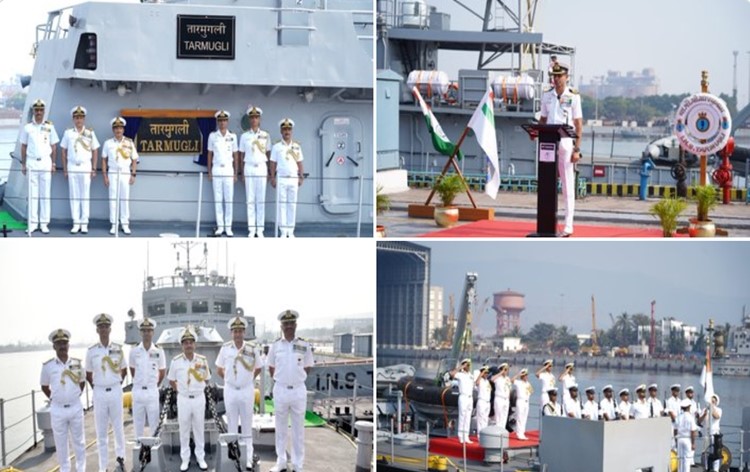Description

Disclaimer: Copyright infringement not intended.
Context
INS Tarmugli, a Fast Attack Craft has been commissioned into the Navy at a ceremony held at Naval Dockyard, Visakhapatnam.
Details
- Name and Class: INS Tarmugli, a Trinkat Class Fast Attack Craft (FAC).
- Initial Gift: The vessel was initially gifted to the Maldivian Naval Defence Forces (MNDF) by India in 2006.
- Return and Restoration: The ship returned in May and underwent extensive restoration at the Naval Dockyard, Visakhapatnam.
- Features and Capabilities:
- Advanced MTU engines and water jet propulsion.
- Latest communication equipment and an advanced radar system.
- Fitted with a 30 mm gun for defense purposes.
- Purpose and Functionality:
-
- Role: Primarily intended for coastal surveillance.
- Area of Operations: Protection of Offshore Development Areas (ODAs) in the KG Basin area and the East Coast.
- Operational Command: Under the Naval Officer-in-Charge (Andhra Pradesh).
- Speed and Capacity:
-
-
- 320-tonne vessel measuring 48 meters in length.
- Capable of achieving speeds in excess of 30 knots.
-
- Strategic Importance: Vital for maritime security and defense operations.
- Naming Tradition: Named after a picturesque island in the Andaman group.
About Trinkat-class patrol vessels
Role:
- Functions: Fisheries protection, anti-poaching, counter-insurgency, and search-and-rescue operations.
- Operational Area: Primarily in coastal areas and the exclusive economic zone.
- Naming Convention: Named after islands from the Andaman and Nicobar Islands or the Lakshadweep Islands.
Ships in Class:
- Trinkat (T61):
- Homeport: Port Blair
- Commissioned: 28 September 2000
- Status: Active
- Tillanchang (Now INS Tarmugli - T62):
- Commissioned: 17 March 2001
- Transferred: To the Maldivian Coast Guard in April 2006 as MCGS Huravee.
- Decommissioned: 2 May 2023 and transferred back to India.
- Recommissioned: As INS Tarmugli on 14 December 2023 after refit.
- Tarasa (T63):
- Commissioned: 24 August 2001
- Transferred: To Seychelles Coast Guard in November 2014 as PS Constant.
- Tarmugli (T64):
- Commissioned: 4 March 2002
- Transferred: To Seychelles Coast Guard in February 2005 as SCG PS Topaz.
.jpg)
Replacements:
- Newer Ships: Garden Reach Shipbuilders and Engineers developed replacements for the older vessels, known as the Car Nicobar-class patrol vessels.
- Launch Dates:
- New INS Tarasa (T94) launched in June 2016.
- New INS Tillanchang (T92) commissioned in March 2017.
- New INS Tarmugli (T91) commissioned in May 2016.
Recent Developments:
- New INS Tarmugli (T91) donated to the Maldives in May 2023.
- Older MCGS Huravee (formerly INS Tillanchang) transferred back to India.
- INS Tarmugli (formerly Tillanchang) was refitted and recommissioned into the Indian Navy on 14 December 2023.
About FAC
- Fast Attack Craft (FAC) is a type of small, agile, and highly maneuverable naval vessel designed primarily for offensive and defensive operations in littoral or coastal areas.
- These crafts are built for speed, flexibility, and rapid response, often playing a crucial role in coastal defense, patrolling, escort duties, anti-submarine warfare, and protection of larger naval vessels.
Design and Characteristics:
- Size and Construction:
- Typically small in size, ranging from around 20 meters to 50 meters in length, allowing for high maneuverability and speed.
- Lightweight construction using advanced materials, such as aluminum or composites, for speed and agility.
- Speed and Maneuverability:
- Emphasis on high speed, capable of reaching and sustaining speeds often exceeding 40 knots.
- Swift acceleration and quick turning capabilities for rapid response and evasion of threats.
- Armament and Payload:
- Mounts a variety of offensive weaponry, such as naval guns, surface-to-surface missiles, anti-ship missiles, torpedoes, and close-in weapon systems (CIWS).
- May also carry electronic warfare systems, decoys, and small unmanned aerial or surface vehicles.
- Stealth and Survivability:
- Some designs incorporate stealth features, reduced radar signature, and advanced sensor technologies.
- Countermeasures against threats include sophisticated electronic warfare suites and defensive systems.
Roles and Missions:
- Coastal Defense:
- Protecting territorial waters by patrolling and monitoring activities in coastal areas.
- Providing rapid response to threats such as piracy, smuggling, and intrusions by hostile forces.
- Escort and Protection:
- Escorting larger naval vessels or convoys, safeguarding them against surface and subsurface threats.
- Anti-Submarine Warfare (ASW):
- Engaging and countering enemy submarines using torpedoes and other ASW weapons.
- Surveillance and Reconnaissance:
- Conducting surveillance missions to gather intelligence and monitor maritime activities.
Global Use:
- United States Navy (USN):
- The Cyclone-class patrol ships, serving in littoral areas, providing fleet support, and executing maritime security operations.
- Russian Navy:
- The Tarantul-class missile corvettes, designed for anti-ship warfare and used for coastal defense and convoy escort.
- Indian Navy:
- The Abhay-class corvettes, optimized for shallow water operations and anti-submarine warfare in littoral regions.
- Chinese Navy (PLAN):
- Utilizes various classes of missile boats and fast attack crafts for coastal defense and regional security.

Conclusion
The Trinkat-class and its replacements, the Car Nicobar-class patrol vessels, signify India's commitment to maritime security, exemplified by their roles in various critical operations in coastal regions and EEZs. The recent recommissioning of INS Tarmugli is a testament to the Navy's consistent efforts in bolstering its fleet for national defense and coastal security.
|
PRACTICE QUESTION
Q. Elaborate on the strategic significance of Fast Attack Craft (FAC) in the Indian Navy's fleet and their role in bolstering coastal defense. Discuss the operational capabilities and technological advancements of Fast Attack Craft in enhancing India's maritime security. (250 Words)
|
















